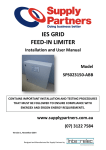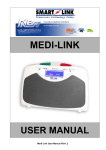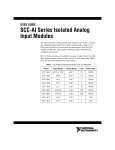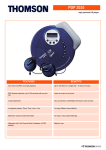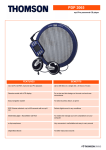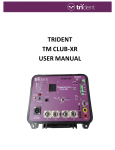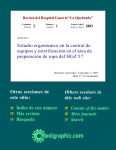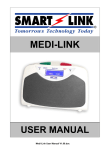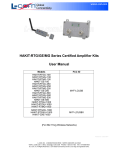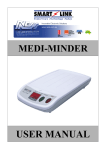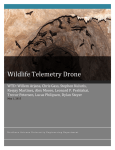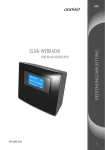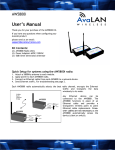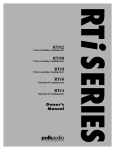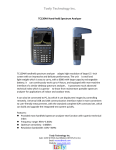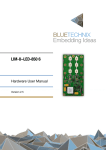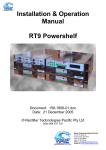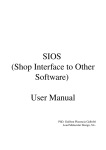Download RFD900 Datasheet - RFDesign Files
Transcript
RFD900 Radio Modem Data Sheet RFD900 Product Specifications and Performance RFD900 Configuration RFD900 Modem Tools User Manual RFDesign Pty Ltd 6/97 Jijaws Street Sumner Park, QLD 4074 rfdesign.com.au RFDesign Pty Ltd - RFD900 Data Sheet Contents 1. Key Features................................................................................................................................ 4 2. Specifications .............................................................................................................................. 5 3. Power Levels ............................................................................................................................... 5 4. Performance Characteristics ....................................................................................................... 6 5. Pin Signals and Layout................................................................................................................. 9 6. Software/GCS Support .............................................................................................................. 10 7. Antenna Connectivity................................................................................................................ 11 7.1. Diversity ............................................................................................................................ 11 • Spatial Diversity..................................................................................................................... 11 • Polarisation Diversity ............................................................................................................ 11 7.2. Types of Antennas............................................................................................................. 12 • Yagi Antenna ......................................................................................................................... 12 • Quarter Wave Monopole Antenna ....................................................................................... 12 • Half Wave Dipole Antenna .................................................................................................... 13 8. AT Commands ........................................................................................................................... 14 9. Air Data Rate ............................................................................................................................. 16 10. Network Options ................................................................................................................... 17 11. RFD900 Modem Tools User Manual ..................................................................................... 18 11.1. Introduction .................................................................................................................. 18 11.2. Requirements – for End Users ...................................................................................... 18 11.3. User Interface................................................................................................................ 19 • Configuration Tab ................................................................................................................. 19 • Firmware Tab ........................................................................................................................ 20 12. Frequently Asked Questions (FAQ) ....................................................................................... 21 How many antennas do I need to use? ........................................................................................ 21 How do I connect the FTDI cable to the modem? ........................................................................ 21 What do I need to upload the firmware or to change the modem configuration?...................... 21 What should I do if the RFD900 Modem Tools application keeps giving me back error messages? ...................................................................................................................................................... 21 I upgraded to V2.x firmware and the modems don't connect anymore? .................................... 21 How do I configure 2 base stations and one Airborne platform with 3 modems?....................... 21 13. Useful Links ........................................................................................................................... 22 RFD900 Firmware.......................................................................................................................... 22 2 RFDesign Pty Ltd 31/05/2013 RFDesign Pty Ltd - RFD900 Data Sheet RFD900 Modem Tools ................................................................................................................... 22 Software Solution Sik V1.x ............................................................................................................ 22 3DR Radio Configuration Tool ....................................................................................................... 22 3 RFDesign Pty Ltd 31/05/2013 RFDesign Pty Ltd - RFD900 Data Sheet 1. Key Features RFD900 provides compact and yet powerful data communication. The key features are: • • • • • • • • No configuration required for out of the box RF communications. Operating frequency range of 902 – 928MHz Outdoor RF line-of-site range of 40km or more depending on antennas Air data rate speeds of up to 250kbps Diversity antenna support Operating temperature of -40 to +85 degrees Celsius Dimensions of 30mm x 57mm x 12.8mm Weight of 14.5g Compliances and Worldwide Acceptances: The RFD900 is designed to be compliant to AS4268:2012, and FCC 15.247. It has not been certified as a standalone modem and should be compliance tested in the final product. 4 RFDesign Pty Ltd 31/05/2013 RFDesign Pty Ltd - RFD900 Data Sheet 2. Specifications Performance Supported RF Data Rates Indoor Range Line-Of-Sight Range Transmit Power Receiver Sensitivity Low Noise Amplifiervv 4, 8, 16, 19, 24, 32, 48, 64, 96, 128, 192 and 250 500m – 1km 40km or more depending on antennas 0 to 30dBm in 1dBm steps >121dBm at low data rates, >TBA at high data rates >20dB Features Serial Data Interface Configuration Method Frequency Band Interference Immunity Serial Interface Data Rate Antenna Options GPIO Compliance Standards +3.3V nominal, 5V tolerant AT Commands, APM Planner, Customised Configuration Tool 902MHz - 928MHz FHSS (Frequency Hopping Spread Spectrum) 2400, 4800, 9600, 19200, 38400, 57600, 115200 baud Yagi, ½ Wave Dipole, ¼ Wave Monopole Antenna 6 pins (Digital, ADC, PWM capable) FCC Part 15.247, AS/NZS 4268:2008 Networking and Security Addressing Options Network ID: 0 –499 Channels Up to 50 Frequency Hopping Channels 1 Supported Network Topologies Point to point, Multipoint 1 Only available in firmware version 2.x and later Power Requirements Supply Voltage Transmit Current Receive Current +5V nominal (+4V min, +5.5V max), ~1 A peak at max power ~60mA 3. Power Levels Many countries have different legal power levels. Be sure to operate within the legal power limits of the country that you are operating in. The RFD900 modem can support the power levels between 0dBm and 30dBm in 1dBm steps. Formula (1) can be used to convert the power in dBm into milliwatts. = 10( /) (1) To calculate Effective Isotropic Radiated Power (EIRP) you can use the equation (2) below: () = !()– #$%!%() + '!(()(2) The FCC limit for EIRP is 4 Watts, or 36dBm for frequency hopping radios in the ISM 900 MHz band. The Australian EIRP limit is 30dBm as defined by ACMA. 5 RFDesign Pty Ltd 31/05/2013 RFDesign Pty Ltd - RFD900 Data Sheet 4. Performance Characteristics Figure 4.1 shows how the output power of the RFD900 varies with supply voltage. 29.6 29.4 29.2 Power Output (dBm) 29 28.8 28.6 28.4 28.2 28 27.8 27.6 4 4.5 5 5.5 Vcc (V) Figure 4.1: Output Power of RFD900 vs. Input Supply Voltage to the RFD900 6 RFDesign Pty Ltd 31/05/2013 RFDesign Pty Ltd - RFD900 Data Sheet Figure 4.2 shows how the current through the RFD900 varies with the transmit power level. The current during transmission is shown by the ‘High Level’ plot and that during receive mode is shown by the ‘Low Level’ plot. 1.4 High Level Low Level 1.2 Current (A) 1 0.8 0.6 0.4 0.2 0 -5 0 5 10 15 Power Level (dBm) 20 25 30 Figure 4.2: Current consumption of the RFD900 modem vs. TX power level 7 RFDesign Pty Ltd 31/05/2013 RFDesign Pty Ltd - RFD900 Data Sheet Figure 4.3 shows the occupied bandwidth (-20dB points) against the air data rate. 750 700 Occupied Bandwidth (kHz) 650 600 550 500 450 400 350 300 250 0 50 100 150 Air Data Rate (kbps) 200 250 Figure 4.3: Occupied Bandwidth vs. Air Data Rate 8 RFDesign Pty Ltd 31/05/2013 RFDesign Pty Ltd - RFD900 Data Sheet 5. Pin Signals and Layout Pin # 1 2 3 4 5 6 7 8 9 10 11 12 13 14 15 16 Name GND GND CTS Vcc Vusb Vusb RX P2.3 TX P2.2 RTS P2.1 P0.1 P2.0 P2.6 GND Direction Either Input Either Output Either Either Either Either Either Either - Description Ground Ground Clear to send Power supply Power supply from USB Power supply from USB UART Data In Digital I/O UART Data Out Digital I/O Request to send Digital I/O Digital I/O Digital I/O Digital I/O Ground Max Voltage 0V 0V 5V 5V 5V 5V 5V 5V 5V 5V 5V 5V 5V 5V 5V 0V Figure 5.1: Physical Pin Layout of the RFD900 Radio Modem The FTDI cable (see Useful Links) is compatible with the RFD900 modem. Pin 1 of the FTDI cable (black wire) should connect to pin 1 of the RFD900 header. In order to power the modem from the +5V USB power, a jumper is needed to connect pins 4 and 6. To power the modem from an external +5V supply, connect the power to pins 2 and 4 as shown in figure 5.1. In case there is need to force the modem into boot mode, short circuit pads 1 and 2 (labelled BOOT) on the 9 way test pads. 9 RFDesign Pty Ltd 31/05/2013 RFDesign Pty Ltd - RFD900 Data Sheet 6. Software/GCS Support The software solution (see Useful Links) is an open source development which is also compatible with RFD900 Modem Tools (see Useful Links) and the 3DR Radio Config (see Useful Links) from 3D Robotics. It is called “SiK” and was created by Mike Smith and improved on by Andrew Tridgell and RFDesign. A boot loader and interface is available using RFD900 Modem Tools and field upgrade of the modem firmware via the serial port. The RFD900 Radio Modem is compatible with many configuration methods like the AT Commands and APM Planner. The AT Commands can be used to change parameters such as power levels, air data rates, serial speeds etc. Integrated support for configuring the RFD900 Radio Modem is supported by the APM Planner, with other GCS solutions in development. Its default serial port settings are as follows: • • • • 57600 baud rate No parity 8 data bits 1 stop bit The RFD900 Radio Modem has many software features which include: • • • • • • • • Frequency Hopping Spread Spectrum Transparent Serial Link Configuration by simple AT commands for local radio, RT Commands for remote radio User configurable serial data rates and air data rates Error correction routines, Mavlink protocol framing (user selectable) Mavlink radio status reporting (Local RSSI, Remote RSSI, Local Noise, Remote Noise) Automatic antenna diversity switching on a packet basis in realtime Automatic duty cycle throttling based on radio temperature in order to avoid overheating 10 RFDesign Pty Ltd 31/05/2013 RFDesign Pty Ltd - RFD900 Data Sheet 7. Antenna Connectivity 7.1. Diversity The RFD900 has two antenna ports and firmware which supports diversity operation of antennas. During the receive sequence the modem will check both antennas and select the antenna with the best receive signal. In the case of only one antenna connected, it will automatically select the port with the antenna connected. Testing by Silicon Labs has shown that link budgets can be improved in the order of 6-8dB by employing a diversity scheme. • Spatial Diversity Spatial diversity is the case where the antennas are separated by some distance from one another. It is recommended that two antennas connected to the RDF900 modem be separated by at least 25cm, more if possible. • Polarisation Diversity Polarisation diversity is the case where the antennas are perpendicular to each other. i.e. one vertical, and one horizontal. This is effective in reducing multipath effects which affect one or the other polarisation. 11 RFDesign Pty Ltd 31/05/2013 RFDesign Pty Ltd - RFD900 Data Sheet 7.2. Types of Antennas Below are some examples of antennas that can be used with the RFD900 modems. • Yagi Antenna Figure 7.1: 900MHz 6dBi Yagi Antenna Yagi antennas are recommended for Ground-Station applications due to their size. They have approximately 6dBi gain and give significant link budget improvement when compared to standard dipole, or monopole antennas. • Quarter Wave Monopole Antenna Figure 7.2: 900MHz Quarter Wave Monopole Antenna Quarter Wave Monopole Antennas are recommended for air-borne, or space constrained applications. They are required to be mounted on a ground plane of approx 20cm diameter or more to operate as intended. Using an RF extension cable with an RPSMA bulkhead connector will give good mounting options. 12 RFDesign Pty Ltd 31/05/2013 RFDesign Pty Ltd - RFD900 Data Sheet • Half Wave Dipole Antenna Figure 7.3: 900MHz Half Wave Dipole Antenna The half wave Dipole antenna has approx 3dBi gain with an omnidirectional radiation pattern. It is suited for ground station, or large airborne applications. 13 RFDesign Pty Ltd 31/05/2013 RFDesign Pty Ltd - RFD900 Data Sheet 8. AT Commands The RFD900 modem can support the Hayes ‘AT’ modem command set for configuration. The AT command mode can be entered by using the ‘+++’ sequence. When doing this, you have to wait for 1 second before and after entering the command mode in order to prevent data being interpreted as data. When you are successfully in the AT command mode, an ‘OK’ prompt will be displayed on the screen and the RFD900 modem will stop displaying information from the other modem. Whilst in AT mode, you can use the AT commands to control the local RFD900 modem or the RT commands to control the remote modem. To set certain registers to a particular value, follow these steps: 1. Use the command ATSn=X where n is the register number and X is the actual value. 2. Use the command AT&W to write the new values to the RFD900 modem. 3. Use the command ATZ to reboot the RFD900 modem. Figure 8.1 shows a table that gives a list of AT commands and their description. AT Command ATI ATI2 ATI3 ATI4 ATI5 ATI6 ATI7 ATO ATSn? ATSn=X ATZ AT&W AT&F AT&T=RSSI AT&T=TDM AT&T Description Shows the radio version Shows the board type Shows board frequency Shows board version Shows all user settable EEPROM parameters Displays TDM timing report Displays RSSI signal report Exits AT command mode Displays radio parameter number ‘n’ Sets radio parameter number ‘n’ to ‘X’ Reboots the radio Writes current parameters to EEPROM Resets all parameters to factory defaults Enables RSSI debugging report Enables TDM debugging report Disables debugging report Figure 8.1: AT Commands and their description Figure 8.2 shows a table that gives a list of RT commands and their description. The x parameter is optional where x is the node ID. For example: use RTI,1 to get RTI value for node 1 or simply use RTI to get the RTI value for the node set in the local NODEDESTINATION (see RFD900 Parameters in figure 8.3). AT Command RTI[,x] RTI2[,x] RTI3[,x] RTI4[,x] RTI5[,x] RTI6[,x] RTI7[,x] Description Shows the radio version. Shows the board type Shows board frequency Shows board version Shows all user settable EEPROM parameters Displays TDM timing report Displays RSSI signal report 14 RFDesign Pty Ltd 31/05/2013 RFDesign Pty Ltd - RFD900 Data Sheet RTO[,x] RTSn? [,x] RTSn=X[,x] RTZ[,x] RT&W[,x] RT&F[,x] RT&T=RSSI[,x] RT&T=TDM[,x] RT&T[,x] Exits AT command mode on the remote node Displays radio parameter number ‘n’ Sets radio parameter number ‘n’ to ‘X’ Reboots the radio Writes current parameters to EEPROM Resets all parameters to factory defaults Enables RSSI debugging report Enables TDM debugging report Disables debugging report Figure 8.2: RT Commands and their description Figure 8.3 shows a table with more details about the parameters that can be set in the RFD900 modem. S Reg # S Register Description Default Val Max Val Min Val 0 FORMAT This is for EEPROM version, it should not be changed Firmware dependant N/A N/A Should be the same at both ends of the link for successful communication ? No 1 SERIAL_SPEED Serial speed in ‘one byte form’ 57 115 2 No 1 2 AIR_SPEED Air data rate in one byte form 64, 128 250 2 Yes 3 NETID Network ID. It should be the same on both modems 25 499 0 Yes 4 TXPOWER Transmit power in dBm. Maximum is 30dBm 20, 27 30 0 No 5 ECC Enables or disables the golay error correcting code 1, 0 1 1 0 Yes 6 MAVLINK Enables or disables the MAVLink framing and reporting 1, 0 1 1 0 No 7 OP_RESEND OpportunicResend 1, 0 1 1 0 No 8 MIN_FREQ Min freq in KHz 915,000 927,000 902,000 Yes 9 MAX_FREQ Max freq in KHz 928,000 928,000 903,000 Yes 3 4 5 1 1 10 NUM_CHANNELS Number of frequency hopping channels 50, 20 50 5 Yes 11 DUTY_CYCLE The percentage of time to allow transmit 100 100 10 No 12 LBT_RSSI 0 1 0 Yes 13 MANCHESTER 0 1 0 Yes 14 RTSCTS 0 1 0 No 15 NODEID 29 0 N/A 16 NODEDESTINATION Listen before talk threshold (This parameter shouldn’t be changed) Manchester encoding (This parameter shouldn’t be changed) Ready To Send and Clear To Send (This parameter shouldn’t be changed) Node ID. Base node ID is 0. One node must be acting as a base for a multipoint environment to work. NODECOUNT must be updated first before updating this parameter with bigger number. Remote node ID to communicate with. 29 0 No 2 2 15 RFDesign Pty Ltd 2 1 65535 1 31/05/2013 RFDesign Pty Ltd - RFD900 Data Sheet 2 17 SYNCANY 18 NODECOUNT 2 Set the value to 65535 to broadcast to all nodes. Cannot be the same as NODEID. NODECOUNT must be updated first before updating this parameter with bigger number. If set to 1, allows the modem to send data to all non-base nodes without finding the base. It is strongly recommended to set the value to 0 to avoid unwanted data communication confusion on a multipoint environment. The total number of nodes. 0 1 1 0 No 3 1 30 2 Yes Figure 8.3: RFD900 parameters Notes: 1 Defaults for firmware version 2.* and later 2 Available only for firmware version 2.* and later 3 ECC - Software Detection and correction, extra packet information (twice the packet length) is sent to allow the recovery of corrupted packets. 4 Injects RSSI packet when Mavlink protocol used and heartbeat packet detected. 5 Opportunicresend allows the node to resent packets if it has spare bandwith. 9. Air Data Rate An air speed of 64kps will give a range of about 40km depending on antenna. If the air speed is set to be lower, the range of the wireless link increases but the amount of data that you can send will be limited. Therefore one has to compromise between range and data rate. The data rates that you can choose are only limited to 2, 4, 8, 16, 19, 24, 32, 48, 64, 96, 128, 192 and 250. The air data rate is chosen depending on: • • • • • the range that you need the data rate that you will be sending whether you send data in one direction or both whether you have enabled ECC or not whether you have APM firmware with adaptive flow control 16 RFDesign Pty Ltd 31/05/2013 RFDesign Pty Ltd - RFD900 Data Sheet 10. Network Options RFD900 can be implemented in either simple pair (V1.x, V2.x) or multipoint network (V2.x Only). Node 0 Node 1 Figure 10.1: Two-node Network Setup Node 0 Node 1 (SyncAny = 0) Node 2 Node 3 Node 4 (SyncAny = 1) Figure 10.2: Five-node Network Setup A few notes on the multipoint network (see Figure 10.2): • • • • In order for Node 1 to communicate with Node 2, it has to be able to see Node 0 (the base) and Node 2 If Node 4 cannot see Node 0, to communicate with Node 1, it has to be able to see Node 1 and set the SyncAny parameter to 1 (refer to Figure 8.3: RFD900 parameters). Please note that there is a maximum number of one node which can have SyncAny = 1 parameter in a network to avoid data corruption. More nodes will reduce the bandwidth. 17 RFDesign Pty Ltd 31/05/2013 RFDesign Pty Ltd - RFD900 Data Sheet 11. RFD900 Modem Tools User Manual 11.1. Introduction This GUI is for changing RFD900 modem parameters as well as for uploading firmware. 11.2. Requirements – for End Users Download and copy two files from RFDesign website (see Useful Links) and put them in the same folder: 1. RFD900ModemTools.exe 2. RFD900ModemTools.glade 18 RFDesign Pty Ltd 31/05/2013 RFDesign Pty Ltd - RFD900 Data Sheet 11.3. User Interface • Configuration Tab Figure 11.1: Configuration Tab – Modem Tools To communicate with the modem, make sure you connect the modem to the computer using FTDI cable. Use the COM Port combobox to choose the correct COM port to which the modem is connected. Use the Refresh button to refresh the COM combobox list after connecting/disconnecting a modem. Set Node Destination to 65535 to send data to all nodes. All other comboboxes and checkbuttons are self-explanatory. Use Update Settings button to write setting changes to the modem. Initially, this button is disabled and will be enabled once the Load Settings button is clicked. Use the Load Settings button to load settings from the modem. Use Reset Factory Settings button to reset the current modem settings to the factory settings. 19 RFDesign Pty Ltd 31/05/2013 RFDesign Pty Ltd - RFD900 Data Sheet • Firmware Tab Figure 11.2: Configuration Tab – Modem Tools Use the COM Port combobox to choose the correct COM port to which the modem is connected. Use the Refresh button to refresh the COM combobox list after connecting/disconnecting a modem. Download the firmware from the RFDesign website (see Useful Links) and put the file on the same folder as this RFD900 Modem Tools application. Browse for the file using the “...” button then click the Upload button to upload the new firmware to the modem. 20 RFDesign Pty Ltd 31/05/2013 RFDesign Pty Ltd - RFD900 Data Sheet 12. Frequently Asked Questions (FAQ) How many antennas do I need to use? One is the minimum. Two is recommended. How do I connect the FTDI cable to the modem? The black cable of the FTDI (pin 1) should connect to pin 1 on the modem (see above) What do I need to upload the firmware or to change the modem configuration? Download the latest firmware (see Useful Links). Download the RFD900 Modem Tools (see Useful Links). Connect the FTDI cable to the modem and to a computer. Use the RFD900 Modem Tools to upload the latest firmware or to change the modem configuration (see RFD900 Modem Tools User Manual). What should I do if the RFD900 Modem Tools application keeps giving me back error messages? Make sure to connect the FTDI cable firmly into the modem. Make sure you choose the correct COM port from the COM dropdown box and the correct Baud Rate. Try for two more trials and if it still doesn’t work, disconnect and reconnect the modem. I upgraded to V2.x firmware and the modems don't connect anymore? The default setting for a modem is to have a NODEID set to 1. A network must have one node set to 0 to be the base. The base node defines the synchronisation for the whole network of nodes. How do I configure 2 base stations and one Airborne platform with 3 modems? Set the Airborne platform as follows: NODEID = 0 NODEDESTINATION = 65535 MAVLINK = 1 Set the ground station as follows: NODEID = 1 or 2 NODEDESTINATION = 0 MAVLINK = 1 This will allow the airborne modem to handover to multiple ground stations as it flies from the coverage area of one ground station, to another. Both ground stations can be connected and can control the Airborne platform simultaneously. (APM Planner using Mavlink) 21 RFDesign Pty Ltd 31/05/2013 RFDesign Pty Ltd - RFD900 Data Sheet 13. Useful Links RFD900 Firmware http://rfdesign.com.au/firmware/ V1.x firmware is standard SiK (open source) V2.x firmware is multipoint SiK (MP SiK) RFD900 Modem Tools http://rfdesign.com.au/downloads/ FTDI Cable http://www.ftdichip.com/Support/Documents/DataSheets/Cables/DS_TTL232R_CABLES.pdf Software Solution Sik V1.x https://github.com/RFDesign/SiK 3DR Radio Configuration Tool http://vps.oborne.me/3drradioconfig.zip 22 RFDesign Pty Ltd 31/05/2013
























